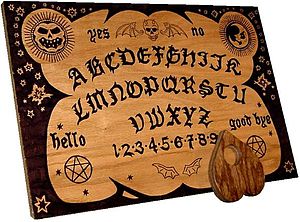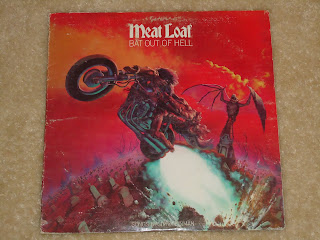LYRIC O’ THE DAY:
Heavenly wine and roses
Seem to whisper to me, when you smile
--Sweet Jane, The Velvet Underground
It was a dark and stormy night.
Ok, not really, but I like to embellish. I was in seventh grade, one of the fortunate few who was invited to Stacy Smith’s** birthday party. It was a night of many firsts for me and my burgeoning adolescence. I experienced my first kiss, a Lady and the Tramp moment thanks to Truth or Dare, the class boy slut, and the vegetable plate Stacy’s mom provided as party food. As an unfortunate result, “celery” was my nickname well into junior high.
**names have been changed to protect the innocent
However, the most eventful part of the night was not Frenching with Veggies 101, but playing with a Ouija board for the very first time. I still remember that musty smell as it slipped out of the cardboard box--like a crypt had been broken open. Some of the girls were scared to even touch the thing; the guys were fighting over who got to ask it when they would get laid for the first time. I don’t remember what else we asked it; I’m assuming maybe deep existential questions like why was New Coke necessary or other stuff that was important in 1985. But before we could get into the nitty gritty of our futures, Stacy freaked out, too panicked to continue. Mr. Ouija is probably still locked in the hallway closet of the Smith home, waiting to be the gateway board game into harder things, like Dungeons and Dragons.
Although there are some accounts of spirit boards being used as early at 600 B.C., the Ouija board in America found its beginnings during the modern Spiritualism movement in the mid-1800s. Spiritualism, quite simply, is the belief that the living can communicate with the dead. During its heyday, seances to contact the deceased became a form of entertainment and many mediums enjoyed celebrity status. Two of the most famous mediums were the Fox sisters from Hydesville, New York. They devised a method of “rapping” in which they would question the dead and the spirit would answer via a code of knocks and pops. Later, one of the sisters admitted that the entire thing was a hoax--the sounds were the controlled popping of their toe joints.
 |
| MOM TOLD ME NOT TO POP MY TOES! |
During this time, a French spiritualist named Planchette invented a device that looked like a heart shaped table with a hole for a pencil. He quite cleverly called it . . . a planchette. By placing his fingertips on the little table, he used it to channel the spiritual connection into written word--a sort of aided automatic writing. He then collaborated with a friend who was a coffin maker to develop a wooden board preprinted with letters, numbers and yes/no to make the channeling even simpler, even for a novice. They sold this idea to an attorney named Elijah Bond and his associate, Charles Kennard, who then patented “the talking board” as a parlor game in 1890.
The “talking board” got its official name from Kennard, who claimed the board named itself during a seance. “Ouija” was supposedly an ancient Egyptian word for “good luck.” According to Egyptian scholars, that’s not the case, but it made no difference as sales of the board flourished at $1 a pop. By 1892, Kennard had been ousted from the company. William Fuld took over marketing, reinventing the story of Ouija, claiming the name was a combo of Oui and Ja, the French and German words for “yes”.
 |
| SEARS AD FOR OUIJA BOARD |
After years of battling patent infringements, Fuld fell to his death in 1927 when a support beam he was leaning against gave way while working on a flagpole at the company. His death only added to the forbidden aura of the Ouija board, which had gained popularity as a true divination tool for occultists. His family sold the board in 1966 to Parker Brothers, who continue to market it as a game for ages 10 and up.
 |
| CURRENT OUIJA GAME FROM PARKER BROS. |
The first Ouija boards were made of coffin wood, and the planchette used a coffin nail as a pointer. In 2010 a hot pink version and a glow-in-the-dark version were sold at Toys ‘R’ Us, much to the chagrin of those who see the Ouija as a tool of the Devil. Ouija opponents cite scripture in which God condemns those who commune with the dead. Old Testament Law supposedly supports the execution of anyone who is a medium or channeler, which spells bad news for Jennifer Love Hewitt. In 2005, Christ Community Church in New Mexico burned Harry Potter books with Ouija boards as “symbols of the occult”. Certainly there have been instances where people have cited spirits from the Ouija board telling them to kill or harm others. These claims are difficult to substantiate, given those involved are often considered clinically insane at baseline.
Even in seventh grade, I remember making everyone around the Ouija table pinky swear they wouldn’t purposely move the pointer. And that first time the planchette moved “by itself”, I certainly thought the spirits were with us. So what really fuels the mystique of the Ouija?
 |
| I'M IN YOUR OUIJA BOARD. |
For some, that’s an easy answer--the messages are from beyond the grave, spelled out by a spirit drawn to a piece of mass-production cardboard.
But if you are of the skeptical ilk, the automatism theory is for you. It relies on a concept described by William Carpenter in 1892 called ideomotor action. This theory states that unconscious motor behavior is the basis for the seemingly involuntary movements of popular divination materials, i.e. dowsing rods, pendulums, and of course, the Ouija board. Carpenter believed that muscular movement could be initiated subconsciously--thus the user of the board is responsible for the board movements but is not aware of it. He cited as examples of other ideomotor based actions: automatic painting, automatic writing, and sleepwalking. Proponents of this theory believe that when the Ouija user concentrates, they enter a mild state of hypnosis, opening a conduit into the subconscious. This is the basis of modern day hypnotherapy.
The area of psychic phenomena was examined in the laboratory setting at Duke University by an American scientist named J.B. Rhine. He later established The Journal of Parapsychology, which still is in print. Rhine’s research refuted the idea that demons produced the movements associated with popular tools of the occult. He popularized concepts like the ideomotor effect, facilitated communication, and self delusion to explain the seemingly unexplainable. Rhine’s wife, Louisa, in the newsletter of the American Society of Psychical Research said this:
“In several ways the very nature of automatic writing and the Ouija board makes them particularly open to misunderstanding. For one thing, because [such communications] are unconscious, the person does not get the feeling of his own involvement. Instead, it seems to him that some personality outside of himself is responsible. In addition, and possibly because of this, the material is usually cast in a form as if originating from another intelligence.”
In the late 60s and early 70s, many self proclaimed Ouija channelers were discredited with simple blindfolds and letter rearrangement during psychic testing. But despite those who call the board simply a romanticized tool of hoaxery (Penn and Teller have a fairly colorful offering on their video Bulls**t), you’re not alone if you still believe in the mystical power of Ouija. Writers seem to have a certain affection for the less tangible explanation--the most famous being Arthur Conan Doyle who supported the belief of Spiritualism. Pearl Curran channeled a spirit she called Patience Worth through the Ouija for twenty years. Their collaboration led to several poems, novels and short stories in the early 1900s. Pulitzer Prize winning poet James Merrill wrote The Changing Light at Sandover, an epic narrative of his communications with angels and spirits via the Ouija board.
 |
| AUTHOR'S OUIJA |
Cinema also highlights the less Candyland side of Ouija. The Exorcist is loosely based on the story of a boy in Maryland who experienced unusual symptoms (i.e. possession by evil spirits) after playing with a Ouija board in an attempt to contact his dead aunt. In the movie, Regan refers to the spirit she contacted via the Ouija board as Captain Howdy--aka Pazuzu the demon of pestilence. One of my favorite Robin Williams’ flicks, Awakenings, starts with the discovery that Robert de Niro’s character is thinking on a subconscious level and can communicate via a game of Ouija. And last, but certainly not least if you love cheesy horror flicks was Witchboard, in which a young woman becomes obsessed with talking to a malevolent spirit via her Ouija board. Not long on plot, but all the dudes in my high school gave it a thumbs up for showing Tawny Kitaen (of Whitesnake hood ornament fame) naked.
The Ouija board has a checkered past, but whether you believe it is just a parlor trick of self-deception or truly a portal to the spirit world depends a lot on your own beliefs about the afterlife. But just in case you are considering a trip to Toys ‘R’ Us later, keep in mind some of the rules of Ouija:
- Don’t play alone or if you are ill--you’re spiritually susceptible to possession
- Don’t play in places where death has occurred or risk possession (i.e. no graveyards)
- Do not let the board go thru the whole alphabet or numbers in order--it’s an attempt for the spirits to escape
- If the planchette goes to all four corners or in a figure 8, you are in the presence of an evil spirit. If you want to prevent this from happening, place a silver coin on the board to stop the evil spirits from coming through
- In order to destroy the board, one must break the board into 7 pieces and sprinkle with holy water, then bury it
 |
| HAPPY CHANNELING! |







































